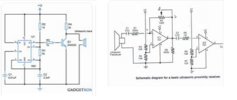I did acquire some experience working with ultrasonic transducers when I worked for a man that developed a device called Preg-Check. I'm from Iowa. Pigs are big business there. Some hog farmers may have several hundred brood sows. Large groups of these sows would be bred at the same time. It was beneficial to determine if a sow was successfully impregnated. If they failed to become pregnant, that was a non-productive animal that still needed food. If, after breeding, within a few days you could proclaim a sow not pregnant, she could be bred again and would farrow with the same group. Hence, Preg-Check. A hand-held device a little larger than a pack of cigarettes. The bred sows were run thru a shoot where they could be stopped and held while the technician would lift a hind leg slightly, press the transducer on the top of the Preg-Check unit against the inside of the flank. The tech would depress a momentary button switch on the unit and one of 2 LEDs would illuminate. Red indicated that the sow was not pregnant, yellow indicated the sow was pregnant. When a sow becomes pregnant her uterus begins to fill with liquid. The liquid has a different density than does the tissue of which the uterus is made. This difference in density would affect the travel time of the reflected supersonic wave returning to the transducer. The Preg-Check had circuitry that would determine if the time period from initial signal sent until the signal reflection was detected, corresponded to pregnant or not pregnant and illuminated the corresponding LED read out. I'll be doing essentially the same thing. I will be comparing the time period of the reflected wave burst to a known value to determine if a vessel contains gas or liquid.


